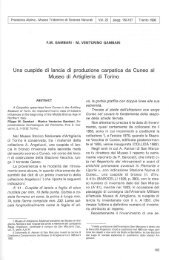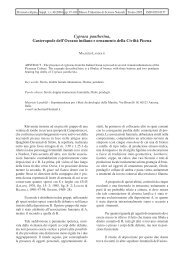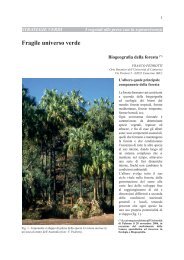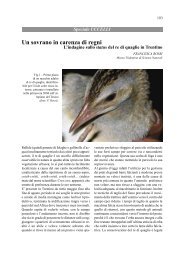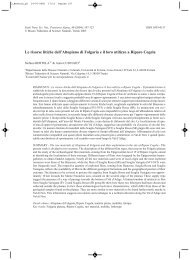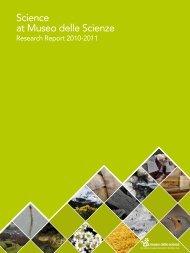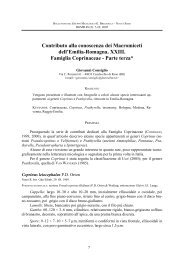Progetto HIGHEST - Relazione Finale - Museo Tridentino di Scienze ...
Progetto HIGHEST - Relazione Finale - Museo Tridentino di Scienze ...
Progetto HIGHEST - Relazione Finale - Museo Tridentino di Scienze ...
Create successful ePaper yourself
Turn your PDF publications into a flip-book with our unique Google optimized e-Paper software.
Milner, A.N. & Petts, G.E. 1994. Glacial rivers: physical habitat and ecology. Freshwater Biology, 32:<br />
295‐307.<br />
Milner, A.N., Brittain, J.E., Castella, E. & Petts, G.E. 2001. Trends of macroinvertebrate community<br />
structure in glacier‐fed rivers in relation to environmental con<strong>di</strong>tions: a synthesis.<br />
Freshwater Biology, 46, 1833‐1847.<br />
Moore, J.W. 1979. Some factors influencing the <strong>di</strong>stribution, seasonal abundance and fee<strong>di</strong>ng of<br />
subarctic Chironomidae (Diptera). Arch. Hydrobiol., 83 (3): 303‐325.<br />
Moretti, G. 1983. Tricotteri (Trichoptera). In: Ruffo S. (ed.) “Guide per il riconoscimento delle<br />
specie animali delle acque interne italiane” C.N.R. AQ/1/196, N.19, 155 pp.<br />
Nachtnebel, H.P. 1998. Possible Impacts of Climate Change on the Hydrology of Alpine Basins.<br />
Procee<strong>di</strong>ngs of Hydrology, Water resources and Ecology in Headwaters Conference, Meran,<br />
Italy (personal comment).<br />
Newbury, R.W. 1984. Hydrological determinants of aquatic insect habitats. In: V.H. Resh & D.M.<br />
Rosenberg (eds.). The ecology of aquatic insects. Praeger, New York: 323‐357.<br />
Nicolai, P. 1983. Blefariceri<strong>di</strong> (Diptera: Blephariceridae). In: Ruffo S. (ed.) “Guide per il<br />
riconoscimento delle specie animali delle acque interne italiane” C.N.R. AQ/1/202, N.25, 45<br />
pp.<br />
Nocentini, A. 1985. Chironomi<strong>di</strong>, 4 (Diptera, Chironomidae: Chironominae, larve). In: Ruffo S. (ed.)<br />
“Guide per il riconoscimento delle specie animali delle acque interne italiane” C.N.R.<br />
AQ/1/233, N.29, 186 pp.<br />
Nolte, U. & Hoffmann, T. 1992. Fast life in cold water: Diamesa incallida (Chironomidae).<br />
Ecography, 15: 25‐30.<br />
Nolte, U. 1989. Chironomid communities of lotic mosses. Acta Biologica Debrecina, Suppl. Oecol.<br />
Hung., 3: 249‐256.<br />
Norris, R.H., McElravy, E.P. & Resh, V.H. 1992. The sampling problem. In: The Rivers Handbook,<br />
Vol. 1: 282‐306.<br />
Ólafsson, J.S. 1992. A comparative study on mouthpart morphology of certain larvae of<br />
Chironomini (Diptera: Chironomidae) with reference to the larval fee<strong>di</strong>ng habits. J. Zool.<br />
Lond., 228: 183‐204.<br />
Oliver, D.R. 1971. Life history of the Chironomidae. A. Rev. Ent., 16: 211‐230.<br />
Pagast, F. 1947 Systematik und Verbreitung der um <strong>di</strong>e Gattung Diamesa gruppiertern<br />
Chironomiden. Arch. Hydrobiol., 41: 435‐596.<br />
Palmer, M.A., Arensburger, P., Martin, A. & Denman, D.W. 1996. Disturbance and patch‐specific<br />
responses: the interactive effects of woody debris and floods on lotic invertebrates.<br />
Oecologia, 105: 247‐257.<br />
Pfankuch, D. J., 1975. Stream Reach Inventory and Channel Stability Evaluation. U.S.D.A. Forest<br />
service, Northern Region, Intermountain Forest and range Experiment Station, Ogden UT<br />
84401, U.S.A., 26 pp.<br />
129



